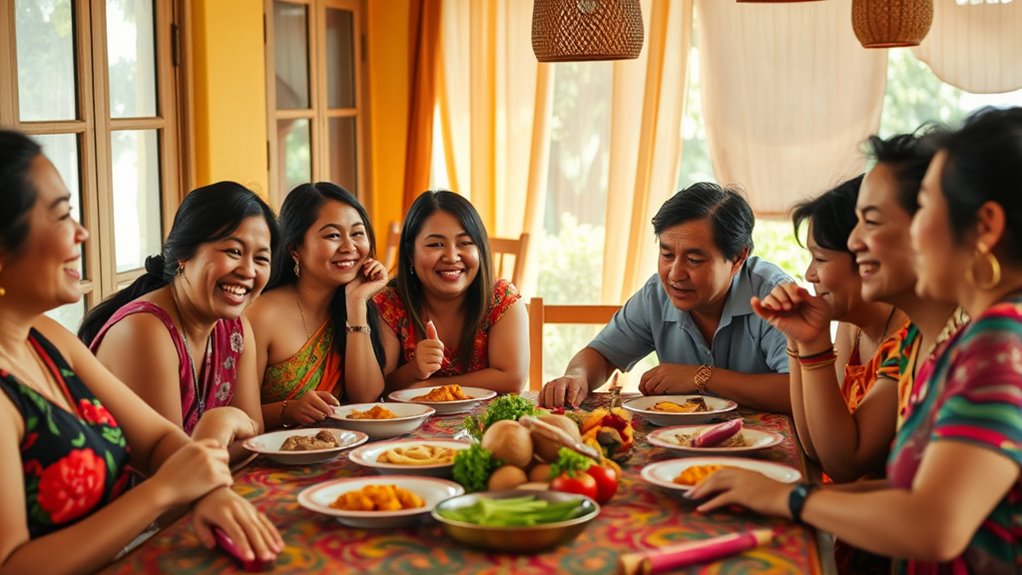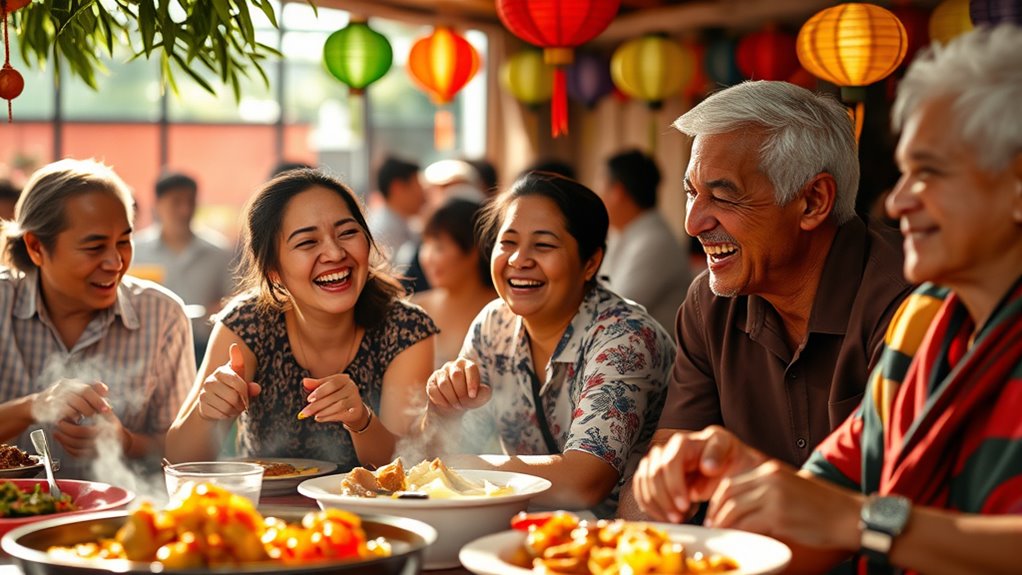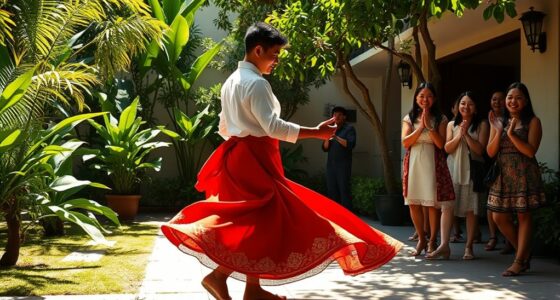To understand Filipina humor in relationships, you need to appreciate its cultural roots and various forms. Embrace authenticity and keep humor relatable. Be open to different styles like self-deprecation or satire, which can lighten conversations. Laughter strengthens bonds, eases tension, and fosters intimacy. Remember to engage actively and respect cultural nuances. By doing so, you’ll enhance your connection and enjoy shared laughs. There’s much more to discover about traversing this colorful aspect of relationships!
Key Takeaways
- Embrace authenticity by engaging with humor that reflects Filipino culture, enhancing emotional connection in relationships.
- Be open to various humor styles, including self-deprecation and sarcasm, as they are common in Filipina humor.
- Share relatable experiences to foster laughter and build rapport, creating cherished memories together.
- Practice active listening to understand cultural references, which can enrich interactions and strengthen bonds.
- Respect cultural differences in humor while maintaining a lighthearted approach, as Filipinos value good-natured fun.
The Cultural Roots of Filipino Humor

Although humor in the Philippines has evolved over centuries, its cultural roots are deeply intertwined with the nation’s complex history of colonization and societal challenges.
Early Filipino humor emerged through traditional oral forms like salawikain and epics, incorporating physical comedy. The Spanish colonial period introduced new comedic styles, such as zarzuelas, blending humor with social commentary.
Early Filipino humor found its roots in oral traditions, evolving through the influence of colonial experiences and the introduction of social commentary.
American colonization further reshaped humor through cinema and Bodabil, expanding comedic narratives. During repressive regimes, political satire became essential, allowing Filipinos to critique society when other forms of dissent were stifled.
Humor acts as a coping mechanism, fostering resilience and strengthening communal bonds. It transcends mere entertainment, addressing injustices while promoting understanding and connection among individuals.
Types of Humor in Filipino Culture

Filipino humor is diverse and reflects the rich tapestry of the culture, characterized by various styles that resonate with different audiences.
Kanal humor, often crude and risqué, thrives in informal settings among younger folks, fostering camaraderie through shared laughter.
In contrast, aircon humor appeals to the elite, using wit to critique social issues, though it may alienate some.
Political satire serves as an essential tool for social commentary, especially in oppressive times, offering a humorous outlet for resistance.
Family and relational humor centers on everyday dynamics, easing tension and celebrating shared experiences.
Finally, meme culture captures relatable moments and societal issues, spreading laughter rapidly through social media, reinforcing community bonds.
Each type plays a unique role in Filipino life.
The Role of Humor in Building Relationships

Humor plays an essential role in building relationships by fostering intimacy and creating shared experiences that deepen emotional connections. When you share laughter, it strengthens your bond and builds trust, allowing both partners to feel more connected.
Humor also reduces stress, preventing it from straining your relationship. By encouraging resilience, it helps you navigate challenges together. In times of conflict, humor acts as a buffer, easing tensions and allowing minor issues to be resolved more smoothly.
A positive outlook nurtured by humor keeps your relationship healthy. Ultimately, incorporating humor into your interactions creates cherished memories, enhances empathy, and promotes unity, making your relationship not only stronger but also more enjoyable.
Humor as a Tool for Communication

Laughter not only strengthens bonds but also serves as a powerful communication tool in relationships. In Filipino culture, humor creates shared experiences that enhance intimacy and emotional connections.
When you share jokes or engage in light-hearted teasing, you signal comfort and safety, allowing for deeper understanding. Humor can also ease cultural differences and help navigate difficult conversations.
When tensions rise, a well-timed joke can diffuse conflict, making sensitive topics more approachable. This shared laughter fosters empathy and collaboration, allowing you to tackle challenges together.
By embracing cultural nuances and practicing spontaneity, you can tailor your humor to fit your partner’s mood, enhancing your interactions and building stronger connections.
Ultimately, humor enriches your relationship and keeps the emotional bond alive.
Navigating Challenges in Understanding Humor

How can you effectively navigate the complexities of understanding humor in relationships? Start by recognizing that cultural backgrounds heavily influence humor.
Filipinas often use irony and sarcasm, which can be tricky if you’re not familiar with the context. Pay attention to media; it shapes humor and reflects societal norms.
Understanding the role of humor as a coping mechanism can also provide insights into its social function. Be aware of gender dynamics—humor can challenge traditional roles and highlight power dynamics.
Finally, don’t overlook language barriers; idiomatic expressions and cultural references can easily get lost in translation.
Tips for Engaging With Filipina Humor

What makes engaging with Filipina humor so unique? It often reflects cultural resilience, using wit and wordplay to bond people.
To connect effectively, embrace authenticity in your humor and keep it culturally relevant. Be open-minded about different humor styles—self-deprecation and sarcasm are common.
Share relatable experiences; this builds rapport and fosters laughter. Active listening is essential; pay attention to cultural references to enhance your understanding.
Encourage storytelling—ask for funny anecdotes to spark joy. Engage in playful banter, and don’t hesitate to use local references.
Most importantly, respect cultural differences and keep your humor lighthearted, as Filipinos appreciate good-natured fun. These tips will help create memorable interactions and strengthen your relationships.
Frequently Asked Questions
How Can I Improve My Own Humor to Connect Better?
To improve your humor and connect better with others, start by observing everyday situations for funny moments.
Practice wordplay and witty remarks, and pay attention to timing and context—knowing when to share a joke is key.
Stay open to feedback and adapt your humor based on the reactions you get.
Are There Specific Jokes That Filipinas Prefer?
You might find yourself chuckling at a clever pun or a playful tease when hanging out with a Filipina.
Jokes that involve wordplay, especially those blending Tagalog and English, often get the best laughs. Self-deprecating humor‘s appreciated too, as it shows humility.
Observational anecdotes about daily life resonate well, creating a sense of connection.
What Should I Avoid When Joking With a Filipina?
When joking with a Filipina, avoid topics that could be offensive or sensitive, like jokes about poverty or disrespecting elders.
Stay clear of stereotypes and be mindful of cultural norms. Don’t reinforce in-group versus out-group jokes, as they can create boundaries.
Also, steer away from exaggerated teasing that might be misinterpreted.
Instead, focus on light-hearted humor that’s inclusive and respectful to build a positive connection.
How Does Humor Vary Among Different Filipino Regions?
Did you know that humor preferences can differ markedly among the 7,641 islands of the Philippines?
In regions like Luzon, you might encounter witty wordplay, while in Visayas, locals often favor storytelling filled with local references.
Mindanao, on the other hand, leans towards humor that reflects cultural diversity.
Each area’s unique dialect and traditions shape its comedic style, making Filipino humor a vibrant tapestry of regional flavors.
Enjoy exploring these differences!
Can Humor Help in Overcoming Cultural Misunderstandings?
Absolutely, humor can help you overcome cultural misunderstandings.
When you share a laugh, it breaks down barriers and eases tension, making it easier to discuss sensitive topics.
By appreciating each other’s comedic styles, you foster empathy and respect.
Humor can transform awkward moments into opportunities for connection, encouraging open dialogue.
Embracing humor allows you to navigate differences more effectively, leading to stronger relationships built on understanding and acceptance.
Conclusion
So, you thought understanding Filipina humor would be a piece of cake? Well, it turns out it’s more like a challenging puzzle wrapped in a delightful enigma! Embracing the cultural roots and playful nuances can turn awkward moments into bonding experiences. Remember, humor isn’t just about laughter; it’s a bridge that connects hearts. So, immerse yourself, keep an open mind, and don’t worry if you don’t get every joke right away—it’s all part of the fun!









